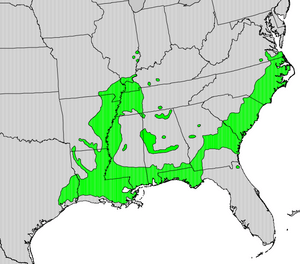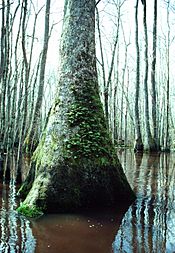Water tupelo facts for kids
Quick facts for kids Water tupelo |
|
|---|---|
 |
|
| A stand of Nyssa aquatica (water tupelo) | |
| Conservation status | |
| Scientific classification | |
| Genus: |
Nyssa
|
| Species: |
aquatica
|
 |
|
| Natural range | |
Nyssa aquatica, commonly called the water tupelo, is a large, long-living tree. You can find it growing in swamps and floodplains. It lives in the Southeastern United States. This tree is special because its trunk has a wide, swollen base. This helps it stand strong even when its roots are underwater for a long time. Water tupelos often grow together in groups, forming their own forests.
What's in a Name?
The scientific name for the water tupelo is Nyssa aquatica. The first part, Nyssa, comes from an ancient Greek word. It refers to a water nymph, a mythical spirit of water. This name makes sense because the tree loves to grow in wet places!
The second part of its name, aquatica, means 'aquatic' or 'water-loving'. This also points to its home in swamps and wetlands.
One of its common names, "tupelo," comes from Native American words. It comes from the Creek words ito, meaning 'tree', and opilwa, meaning 'swamp'. People have been using the name "tupelo" since the mid-1700s.
Why is the Water Tupelo Important?
Water tupelo trees are very useful! A large, grown-up tree can provide good wood for many things. This wood is often used to make furniture and crates.
The wide, swollen base of the Nyssa aquatica trunk is also special. Wood carvers really like this part of the tree. They use it to create beautiful carvings.
Many different kinds of wildlife eat the fruit of the water tupelo. It's also a favorite tree for making honey. Bees love to collect nectar from its flowers!
Gallery






